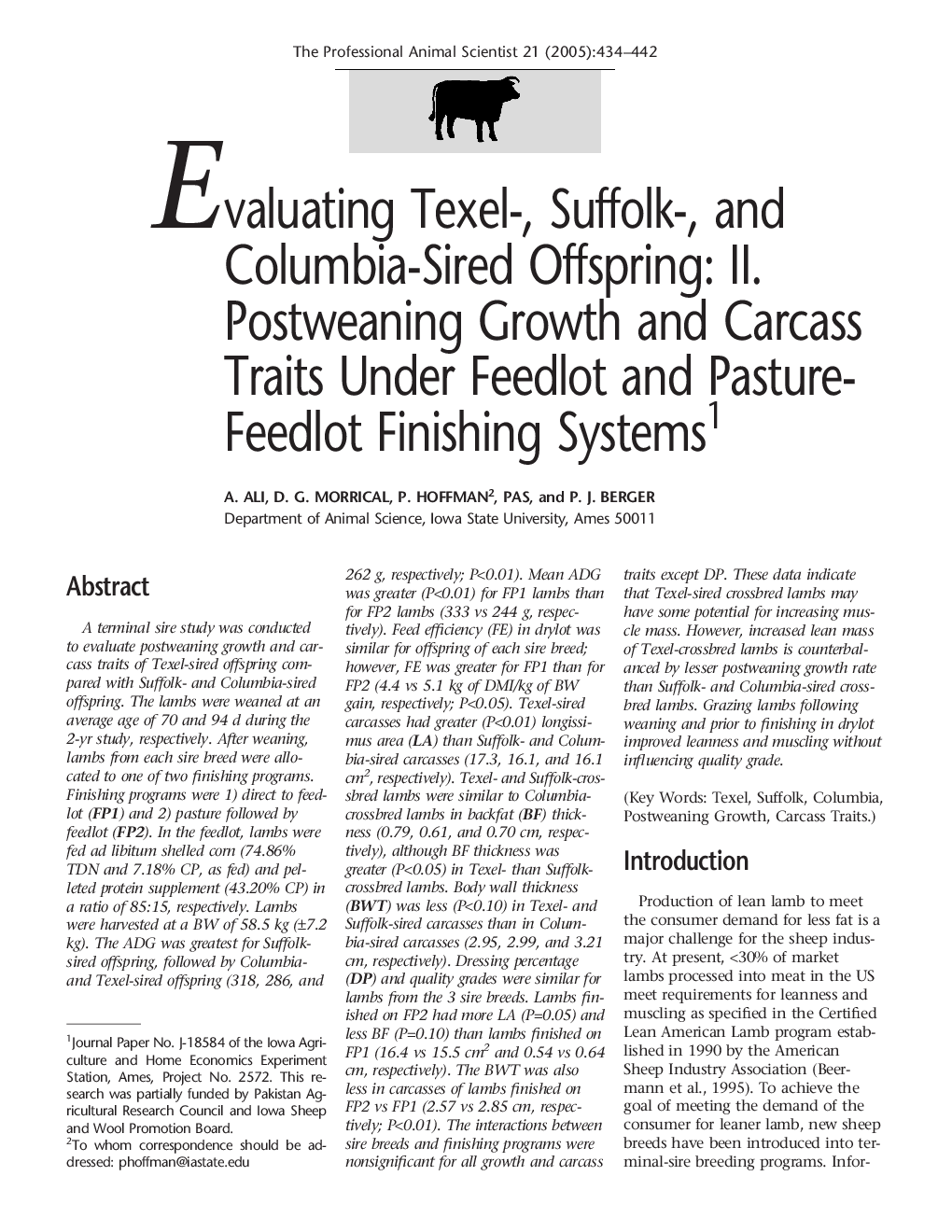| Article ID | Journal | Published Year | Pages | File Type |
|---|---|---|---|---|
| 8985597 | The Professional Animal Scientist | 2005 | 9 Pages |
Abstract
A terminal sire study was conducted to evaluate postweaning growth and carcass traits of Texel-sired offspring compared with Suffolk- and Columbia-sired offspring. The lambs were weaned at an average age of 70 and 94 d during the 2-yr study, respectively. After weaning, lambs from each sire breed were allocated to one of two finishing programs. Finishing programs were 1) direct to feedlot (FP1) and 2) pasture followed by feedlot (FP2). In the feedlot, lambs were fed ad libitum shelled corn (74.86% TDN and 7.18% CP, as fed) and pelleted protein supplement (43.20% CP) in a ratio of 85:15, respectively. Lambs were harvested at a BW of 58.5 kg (±7.2 kg). The ADG was greatest for Suffolksired offspring, followed by Columbiaand Texel-sired offspring (318, 286, and 262 g, respectively; P<0.01). Mean ADG was greater (P<0.01) for FP1 lambs than for FP2 lambs (333 vs 244 g, respectively). Feed efficiency (FE) in drylot was similar for offspring of each sire breed; however, FE was greater for FP1 than for FP2 (4.4 vs 5.1 kg of DMI/kg of BW gain, respectively; P<0.05). Texel-sired carcasses had greater (P<0.01) longissimus area (LA) than Suffolk- and Columbia-sired carcasses (17.3, 16.1, and 16.1 cm2, respectively). Texel- and Suffolk-crossbred lambs were similar to Columbiacrossbred lambs in backfat (BF) thickness (0.79, 0.61, and 0.70 cm, respectively), although BF thickness was greater (P<0.05) in Texel- than Suffolkcrossbred lambs. Body wall thickness (BWT) was less (P<0.10) in Texel- and Suffolk-sired carcasses than in Columbia-sired carcasses (2.95, 2.99, and 3.21 cm, respectively). Dressing percentage (DP) and quality grades were similar for lambs from the 3 sire breeds. Lambs finished on FP2 had more LA (P=0.05) and less BF (P=0.10) than lambs finished on FP1 (16.4 vs 15.5 cm2 and 0.54 vs 0.64 cm, respectively). The BWT was also less in carcasses of lambs finished on FP2 vs FP1 (2.57 vs 2.85 cm, respectively; P<0.01). The interactions between sire breeds and finishing programs were nonsignificant for all growth and carcass traits except DP. These data indicate that Texel-sired crossbred lambs may have some potential for increasing muscle mass. However, increased lean mass of Texel-crossbred lambs is counterbalanced by lesser postweaning growth rate than Suffolk- and Columbia-sired crossbred lambs. Grazing lambs following weaning and prior to finishing in drylot improved leanness and muscling without influencing quality grade.
Keywords
Related Topics
Life Sciences
Agricultural and Biological Sciences
Animal Science and Zoology
Authors
A. Ali, D.G. Morrical, P. Pas, P.J. Berger,
